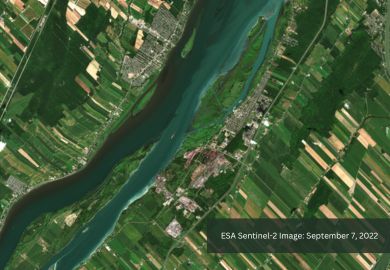Hatfield to support environmental monitoring of Port of Montreal’s expansion project at Contrecœur with innovative satellite remote sensing applications
Jul 18, 2023
Hatfield is excited to announce its collaboration with Public Services and Procurement Canada (PSPC), the Canadian Space Agency (CSA), and the Montreal Port Authority (MPA) on environmental monitoring programs as part of the Port of Montreal expansion at Contrecœur. With overall funding of $4 million from the federal government, the smartHarbour initiative will develop innovative applications using satellite Earth observation (EO) data to track different environmental variables that are important for conserving the biodiversity of natural habitats, both during construction and into the expanded port’s operations.
In March 2021, Environment and Climate Change Canada issued a decision statement allowing the MPA to proceed with its expansion project at Contrecœur provided that it meets a series of conditions, including implementing an environmental follow-up program that uses EO technologies. To address this need for EO monitoring technologies, the MPA is working with PSPC and the CSA under the smartHarbour initiative to monitor several aquatic and terrestrial environmental variables. On behalf of the CSA, PSPC has engaged four Canadian teams to develop these EO applications that will enhance and complement other methods of environmental monitoring.
Hatfield leads a multi-disciplinary team of scientists from the private sector, academia, and a non-government organization to develop terrestrial environmental monitoring applications, including terrestrial vegetation, wetlands, shoreline delineation and erosion trends, and submerged aquatic vegetation. We call our application intelliPort Télédétec-Terre. We will use our GEOAnalytics Canada Platform for big geoscience data analytics to develop and operationalize the applications for efficient end-to-end production.
Hatfield’s team comprises:
- Ducks Unlimited Canada (DUC) – experts and leaders in wetland conservation, DUC’s mission is to conserve wetlands and associated habitats for the benefit of North American waterfowl and to promote a healthy environment for wildlife and people. For over 50 years, DUC has contributed to wetland research to help inform conservation activities in partnership with researchers, industry, and governments.
- Arctus – a private research and development (R&D) company based in Rimouski, Quebec, providing research, development, and applications in remote sensing, EO, and Geographic Information System (GIS) technologies. Arctus specializes in optical remote sensing of aquatic environments, from lakes to oceans.
- Dr. Andrea Bertolo, Université du Québec à Trois-Rivières (UQTR) – professor in the Department of Environmental Sciences at UQTR whose research focuses on aquatic vegetation beds, with direct experience along the St. Lawrence River.
- Dr. Maycira Costa, University of Victoria (UVic) – professor whose research is focused on methods to make more effective use of remote sensing data for understanding and monitoring biophysical processes in ocean waters and wetlands. Her research touches on light attenuation in coastal and riverine waters.
A smartHarbour team led by Arctus will develop aquatic environmental variable monitoring applications. Hatfield is thrilled to be a member of the Arctus team supporting the analysis of shoreline erosion along the St. Lawrence River through the development of river ice monitoring products.
Hatfield has a long history of developing space-based technology to improve environmental assessment and monitoring, specifically in terrestrial and aquatic environments. Our expertise in environmental impact assessment combined with our innovation in the use of EO technologies, big data science, and analytics makes Hatfield a valuable partner to MPA, the CSA, and PSPC in this smartHarbour initiative.
We look forward to collaborating with all experts involved in this important initiative that aims to foster the development and adoption of best practices for environmental monitoring, as well as the protection of terrestrial and aquatic ecosystems along the St. Lawrence River.
For more information on this initiative, read the full announcement on the Canadian Space Agency’s website.
